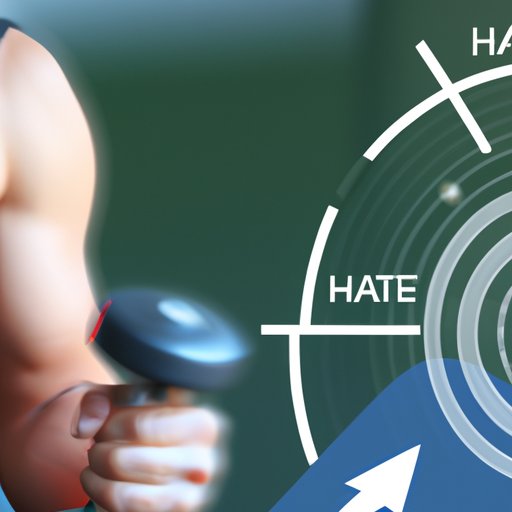
I. Introduction
Have you ever wondered why your heart rate increases during exercise? You’re not alone! It’s a common question that many people have when beginning their fitness journey. In this article, we’ll explore the science behind this phenomenon and its impact on your overall health. We’ll dive into the physiology of exercise, its connection to the cardiovascular system, and how to optimize your fitness routine for maximum benefits.
II. The Science Behind a Racing Heart: Understanding Why Exercise Increases Your Heart Rate
Before we explore why exercise increases your heart rate, let’s define what heart rate is. Heart rate refers to the number of times your heart beats per minute. It’s a crucial health indicator as it reflects the condition of your cardiovascular system.
When you exercise, your body requires more energy to fuel your muscle movements. This increased demand triggers a cascade of physiological responses, including an increase in heart rate. Your heart needs to pump more blood to provide adequate oxygen and nutrients to your muscles.
Several factors influence the increase in heart rate during exercise, including the intensity, duration, and type of exercise. Intense exercises that involve whole body movement, such as running or swimming, will result in a more significant increase in heart rate than low-impact exercises like yoga or walking.
III. Beating Faster for Fitness: Exploring the Connection Between Exercise and Heart Rate
Heart rate monitoring is a critical component of exercising effectively and safely. Tracking your heart rate during exercise will help you define your target heart rate zone (THRZ), which is the optimal level of heart rate during exercise.
Exercising within your THRZ provides the most significant benefits for your cardiovascular system, as it challenges your heart without overworking it. It strengthens your heart, enhances blood flow, and decreases your risk of developing chronic conditions such as heart disease or high blood pressure.
Low-impact exercises, such as walking or yoga, may not increase your heart rate drastically. Still, they offer other health benefits, such as reducing stress and improving mobility. Despite the type of exercise you choose, it’s essential to track your heart rate and optimize your routine accordingly.
IV. Pushing Your Limits: How Exercise Engages Your Cardiovascular System
The cardiovascular system comprises the heart, blood vessels, and blood. It’s responsible for delivering oxygen and nutrients to every cell in your body and removing waste products. Exercise plays a crucial role in engaging and strengthening your cardiovascular system.
When you exercise, your heart pumps faster, and your blood vessels dilate, increasing blood flow to your muscles. This enhanced blood flow improves oxygenation, which promotes healthy cell growth and boosts your overall immune system.
Through regular exercise, your cardiovascular system adapts and becomes more efficient in delivering oxygen and nutrients to your muscles. It results in a decrease in resting heart rate and blood pressure and an increase in overall cardiovascular fitness.
V. Pumping Up Your Pulse: What Happens to Your Heart During Exercise
Your heart is the central organ in the cardiovascular system. It’s responsible for pumping oxygenated blood to your body and deoxygenated blood to your lungs. During exercise, the heart responds by pumping more blood throughout your body to meet your muscles’ increased demand for oxygen and nutrients.
As your heart pumps harder, it becomes stronger, and your overall cardiovascular function improves. Exercise-induced changes in your heart include a decrease in resting heart rate and an increase in stroke volume, which is the amount of blood your heart pumps per beat.
An elevated heart rate during exercise also triggers the release of endorphins, which are hormones that promote feelings of wellbeing and happiness. This is why exercise is considered a natural mood booster.

VI. Heart and Exercise: The Relationship Between Effort and Elevation
Effort refers to how hard your heart is working during exercise, and it is linked to your heart rate. The harder you exercise, the higher your heart rate will be. This is why it’s essential to measure your effort levels during exercise and adjust your routine accordingly.
One way to measure effort during exercise is by using the perceived exertion scale, which ranges from 1 to 10, with 1 being very light activity and 10 being maximal exertion. If you’re exercising within your THRZ, your perceived exertion should range from 4 to 6, depending on the intensity of your workout.
Measuring your effort accurately is crucial for optimizing your workout to achieve maximum benefits while also preventing injury or overexertion.
VII. The Excitement of Exercise: How Your Heart Reacts and Adapts to Physical Activity
The heart is a highly adaptable organ that responds to stressors such as exercise. Through regular physical activity, your heart will adapt and become more efficient in responding to the demands of exercise. This is why consistency is essential in maintaining cardiovascular fitness.
Increasing exercise intensity safely is vital to prevent injury and optimize your workout routine. Gradual increases in exercise intensity and duration will challenge your heart and promote improvements in cardiovascular fitness.
The American Heart Association recommends at least 150 minutes per week of moderate-intensity aerobic exercise or 75 minutes of vigorous aerobic exercise per week. Engaging in regular cardiovascular exercise is essential for maintaining overall health and reducing your risk of developing chronic conditions.
VIII. Conclusion
Exercise is a crucial component of maintaining a healthy lifestyle, and understanding the physiology behind it can help you optimize your physical activity routine. By tracking your heart rate, regulating your effort levels, and consistently challenging your cardiovascular system, you can improve your overall health and wellbeing.
Remember to start gradually and safely increase your exercise intensity to prevent injury and avoid burnout. Use the information in this article to guide you on your fitness journey.
Happy exercising!
Call to Action: Begin monitoring your heart rate during exercise and adjust your routine accordingly. If you’re new to exercise, start slowly and gradually increase the intensity of your workouts. Consult with your healthcare provider if you have any concerns about your cardiovascular health.





